
25 Age-appropriate Educational Toys for Kids and Toddlers
Playing with toys teaches little ones innumerable, valuable lessons and skills.
“Child’s play” is a disputable idiom. “Play” is certainly not a simple, one-dimensional activity as it’s often made out to be. For children between the ages of one and seven, play is one of the ways they learn many crucial life skills, academic skills and pick up information about the world around them.
When you see your child talking to a doll, language skills are being practised. A little one who keeps trying to stack a pile of blocks is learning persistence and seeing the theory of gravity at work. A one-year-old shaking a rattle is learning about cause and effect.
As you can see, playing with toys teaches little ones innumerable, valuable lessons and skills. It can even introduce your toddlers to the principles of important subjects like Science, Technology, Engineering, Arts, and Maths
How to Select Educational Toys for Your Little Learner
Use this set of guidelines for selecting developmentally appropriate toys that best nurture your child’s learning experience, depending on their age.
- Keep safety in mind. Is the paint non-toxic? Is the plastic BPA-free? Are there any sharp edges or small objects that could hurt your child?
- Check the label before purchasing to see if the toy is suitable for your child’s age and skill set. How will it enhance your child’s development?
- Avoid toys that have small parts, especially for toddlers and babies. These parts may be a choking hazard.
25 Educational Toys to Stimulate Your Child’s Mind and Body
With these guidelines in mind, you can now better choose from our comprehensive list of 25 age-appropriate toys for your toddler, preschooler and primary schooler.
You’ll notice that the toys we suggest are not high-tech or complicated. Conversely, they are quite basic – and this is for a very important reason. According to early childhood education expert Professor Jeffrey Trawick-Smith, basic is better. That is because these toys are “open-ended”, meaning, they encourage children to use them in many creative ways. Besides developing creativity, research indicates that play also encourages other important skills in kids, like language and motor skills (both fine and gross). Moreover, a child’s higher executive function skills such as working memory, cognitive flexibility and self control can also be honed through play with carefully-selected toys, suggests child development expert Professor Elizabeth Russell.
All the toys in our list encompass these benefits suggested above. They provide a great balance of play behaviours across all areas of crucial development: creative, intellectual and social.
Toddlers
As young as they are, toddlers are masters at testing their limits — they do a lot of physical “testing” of their environment. You can expect to see them jumping from heights, climbing, or simply rolling about. It is through this behaviour that they are able to form a concept of what danger is. At this age, they also start to enjoy stories, and rapidly learn about language.
These educational toys listed below can expose your toddler to a diverse range of play experiences and enhance key developmental areas like language and fine motor skill development. Many of them, such as blocks and puzzles, also contribute to executive function skills — working memory, self control and cognitive flexibility — in your child.
1) Finger Paint
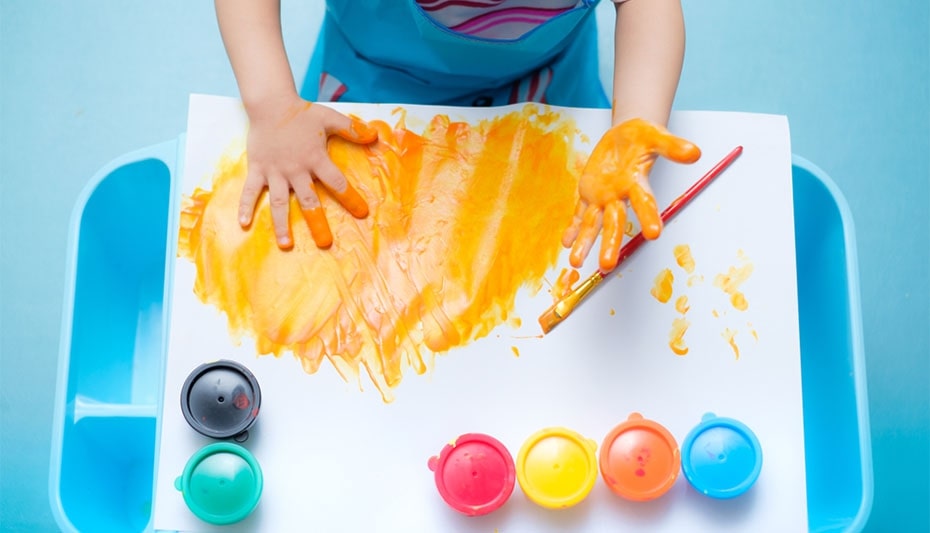
Toddlers love to create a mess and paint! Put these two “loves” together with finger painting for your child. As simple as finger painting may seem, there are a multitude of benefits that are developed by this activity.
Finger painting helps aid your tot’s fine motor development as it strengthens their finger and hand muscles, thereby developing pre-writing skills. It also introduces your child to colours, and stimulates their imagination and creativity.
Pro-tip: Mums and dads, give your toddler full control in this activity. Provide small dishes of paint in different colours. If you’re worried about the mess, dress your child in a waterproof apron and spread a plastic mat on the floor.
2) Shape Sorter
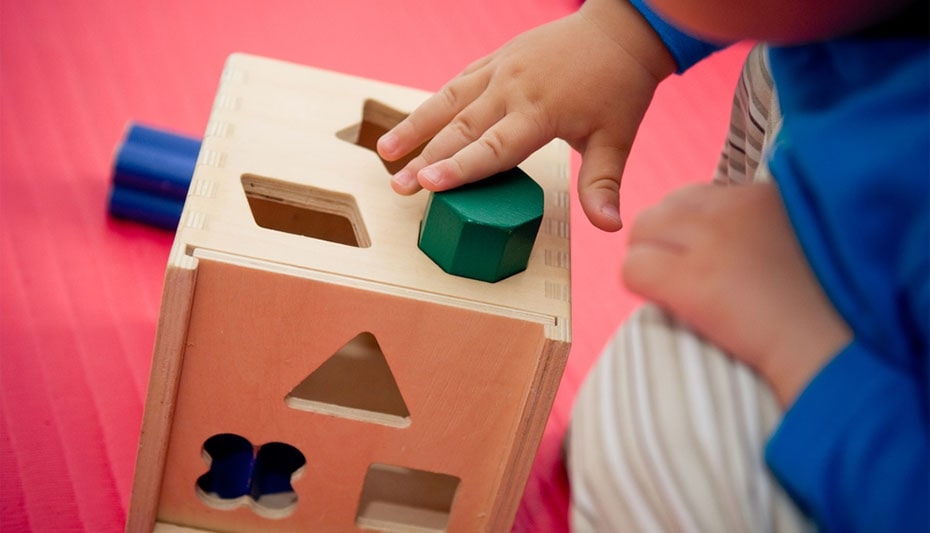
The shape sorter is a great toy for toddlers that allows them to test out their fledgling problem-solving skills. They do this by finding out for themselves where the pieces fit. It also sparks kids’ curiosity while teaching them about cause and effect and object permanence —“When I poke this heart through the hole, it disappears,” and, “Oh, no it didn’t! It came back.”
You can also sit with your toddler as you introduce names of the various shapes and colours. Because children need to grasp and then push the shapes through the respective holes, this toy helps improve fine motor skills. These are the same motor skills needed for writing and related activities.
Pro-tip: Ensure that you verbally label each shape as your toddler picks them up. Take all the pieces except for one, and allow your toddler to move the piece around until they find the matching hole. Repeat until all shapes are accounted for. Praise your child for a job well done!
3) Stacking Cups
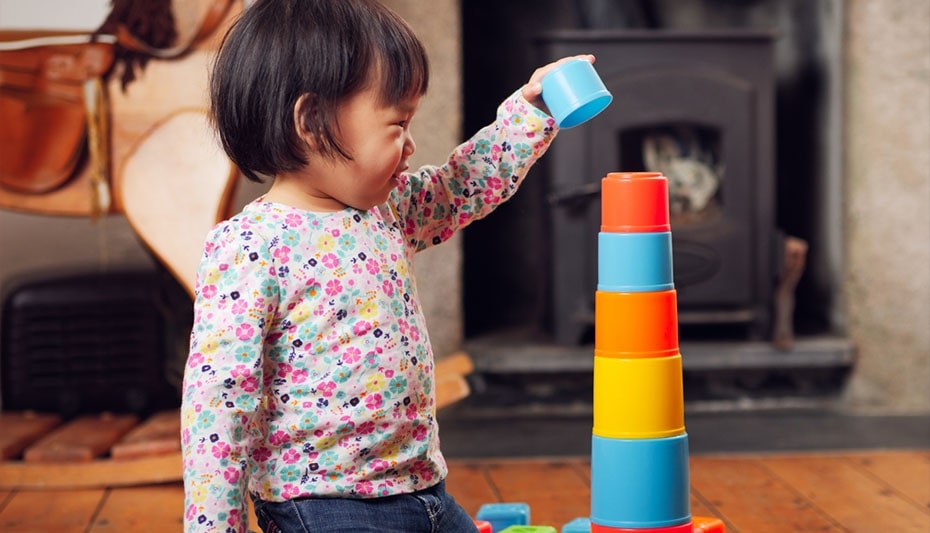
This toy has great learning benefits for toddlers. Learning how to stack, nest, or snap cups together introduces toddlers to numbers, size, and shapes. It also introduces them to the idea of how things fit together (spatial relationships).
Over time, all these actions (stacking, nesting and snapping the cups) may help improve a child's eye-hand coordination and spatial awareness.
Stacking cups also usually come in vibrant colours that stimulate a child’s vision.
Pro-tip: Unlock even more learning fun with water. Yes, stacking cups can be just as educational and fun in the bath, teaching concepts like volume and the behaviour of liquids.
4) Mirrors
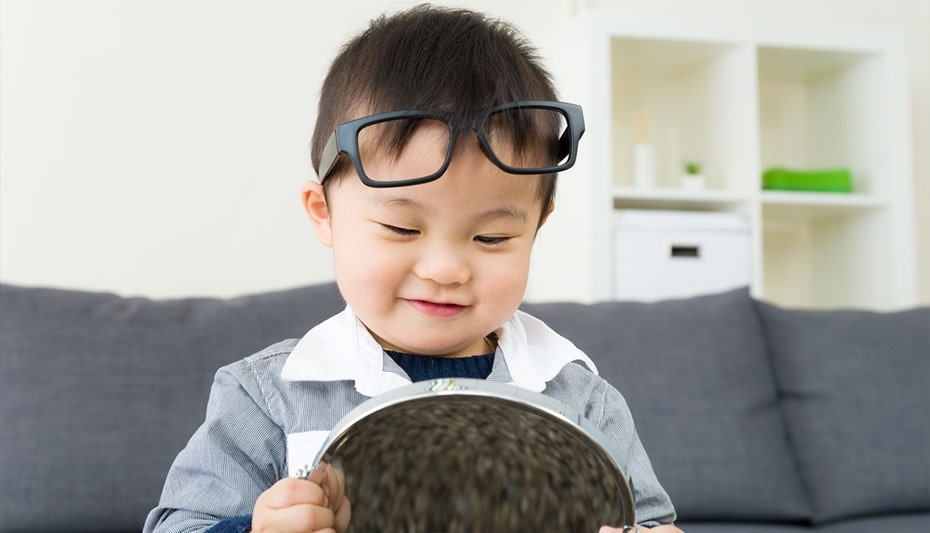
A simple mirror can aid your toddler’s cognitive development. What’s more, it is something that your child can explore without your help, which helps them to learn about self-awareness.
Hold the mirror in front of your child, and encourage him/her to say “Hi!” Then, take the mirror away and ask, “Oh no, where did you go?” Then bring the mirror back. You’re teaching your little one about object permanence using this game.
Pro-tip: Take this opportunity to develop your child’s vocabulary and teach the names of body parts. Mention the different parts of the face as you point to them on your face and your child’s. Or, teach your child about emotions: “Make a happy face!” “Look sad,” and so on.
5) Sandbox
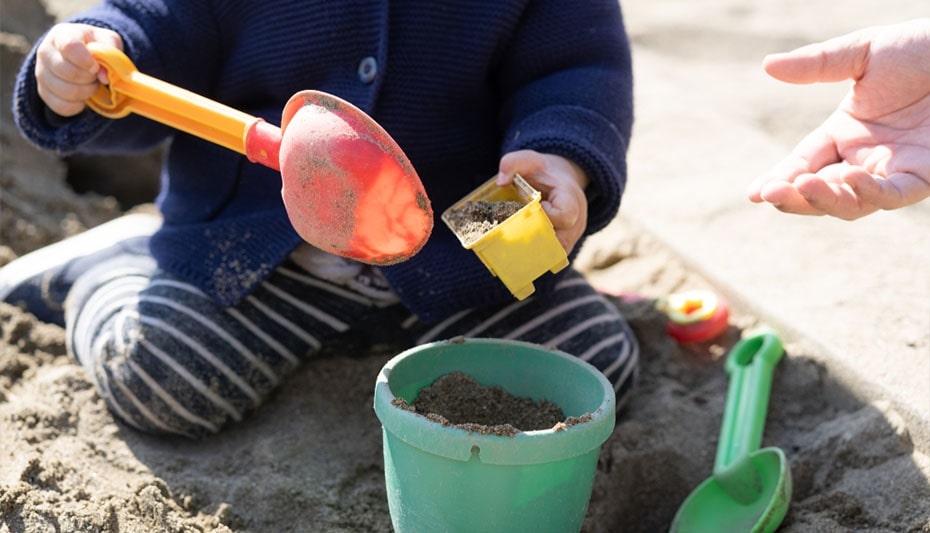
Providing brief independent play opportunities helps to increase feelings of comfort when your child is left alone.
Playing with sand presents many developmental benefits for your child. Sand play gives your little one sensory experience through the texture of sand. It encourages the use of the senses to boost your child’s cognitive learning.
Playing in a sandbox also helps your child to develop social skills like problem solving, sharing, and communicating. This is especially the case in a contained space, where there may be other children around — and it’s incredibly important if you want to build your child’s social-emotional skills.
Pro-tip: Let your child experience and learn how to play independently, but observe and supervise from a short distance. "Your toddler will feel comforted by having you still in the vicinity," says Linda Acredolo, Ph.D., author of Baby Minds: Brain-Building Games Your Baby Will Love.
6) Pegs and Pegboards
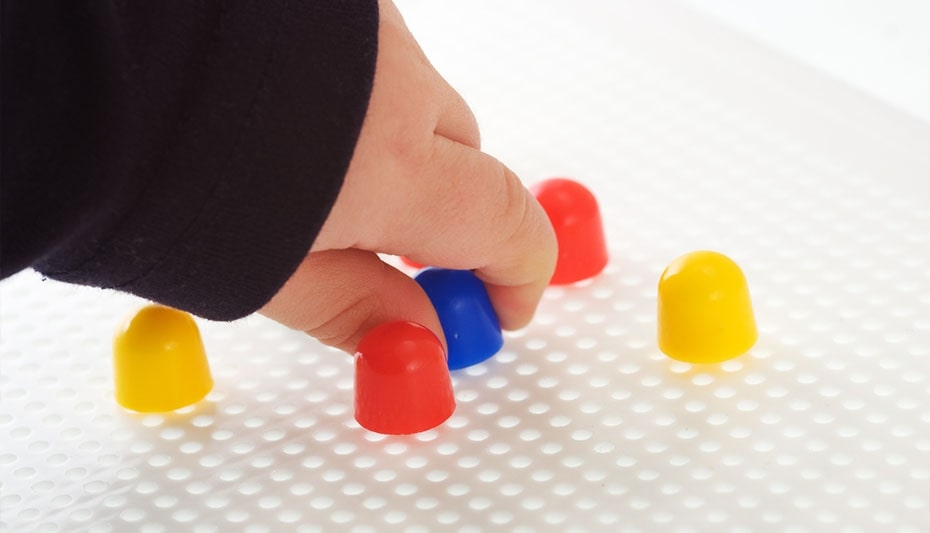
Toddlers tend to have good control of their hands and fingers, and they like experimenting with small objects. Hence, pegboards are extremely versatile toys that your little one will have a tonne of fun with!
They are designed to help children build hand-eye coordination as they fit the various pieces into their respective hollows, with increasing speeds over time. It also enhances fine-motor skills (by learning how to pinch the smaller pegs), colour recognition, early math skills, and even sorting and matching skills as they form their own designs.
Pro-tip: Start with bigger pegs and let your child take the pegs out of the holes as this needs less control and skill. Your child will gradually learn that they have to pinch the smaller pegs out.
7) Bath Toys
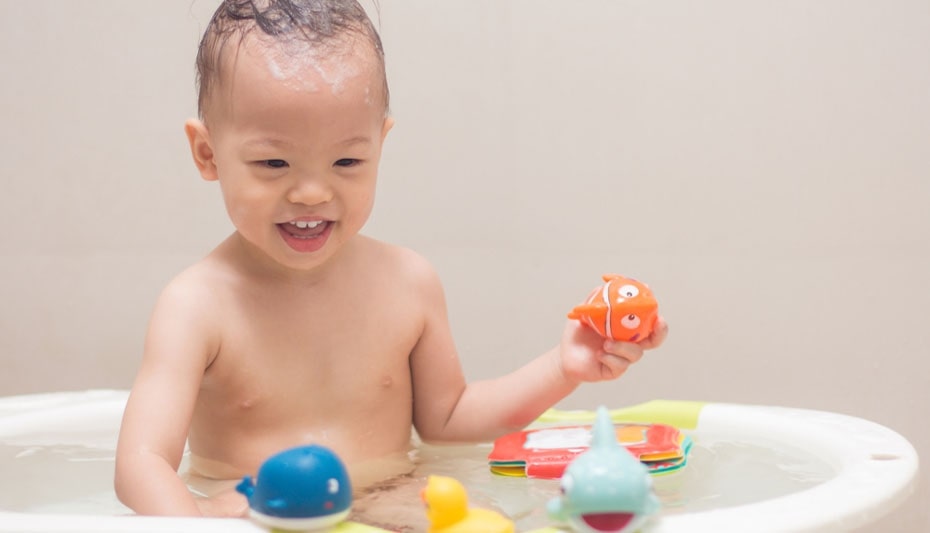
Caption: From floating foam toys, boats to water squirters and stackable bath cups, bath toys come in all shapes and sizes.
Toddlers will have a splashing good time with bath toys. Through these toys, they learn about cause and effect and object permanence. By dropping the toys into the water and picking them up again or squeezing them to produce sounds, children learn that their actions or behaviour lead to a response.
Pro-tip: Introduce your little one early to scientific concepts like density and buoyancy – in a completely fun manner – by providing toys that both float and sink!
8) Stuffed Animals

A stuffed toy is more than just cute. It presents toddlers with the opportunity to pick up essential skills, such as language and social skills.
When toddlers talk to, cuddle and take care of their stuffed toys, they are putting what they have observed in their daily lives to practice. The adorable pretend conversations that they have with their favourite teddy bear? These help them practice their vocabulary, thereby enhancing their language skills.
Toddlers also learn how to share and care (the building of social skills) as they form “friendships” with their stuffed toys. They learn to be more empathetic and form relationships more easily in the future.
Pro-tip: As children love to imitate, show them how to lift their stuffed toys’ arms and legs using gentle movements. This helps teach children to be respectful of others, and be more caring.
9) Balls
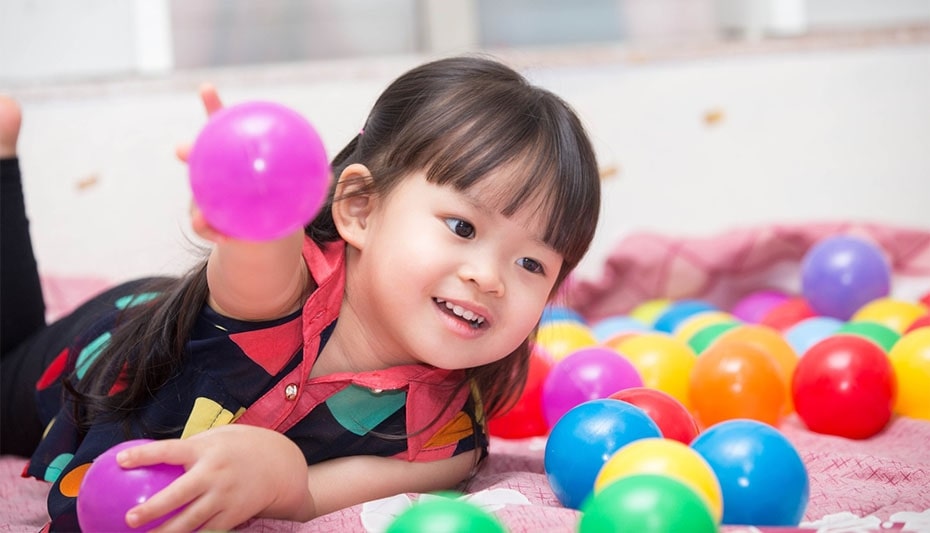
Ball play improves your child’s motor skills, hand-eye coordination, and reflexes. All these contribute to your toddler’s developmental progression. Throwing a ball works your little one’s arm muscles, and running after and kicking a ball, their leg muscles. In addition, ball play with other kids aids your child in developing social skills like sharing, following rules, and negotiating.
Playing with balls will continue to entertain your little one as they grow older, and transitions from independent and parallel play to collaborative play.
Pro-tip: The kind of ball you use to play with your toddler matters. Choose one that is large enough to be held with two hands. A wiffle ball, or any ball with an irregular texture, will help your child get a good grip.
Preschoolers
It’s a land of fantasy for preschoolers as their world “transforms” into a magical place without limits. They are the masters and creators of this world, battling “monsters”, making friends with fairies, and channeling their energies into something larger than they are.
At this stage, they also form a desire to connect with others, which now extends to their preschool friends. This is when the seeds of cooperative play and sharing are planted. This is also a time when play itself becomes more physical and educational toys can contribute to children’s physical and cognitive growth.
10) Puzzles
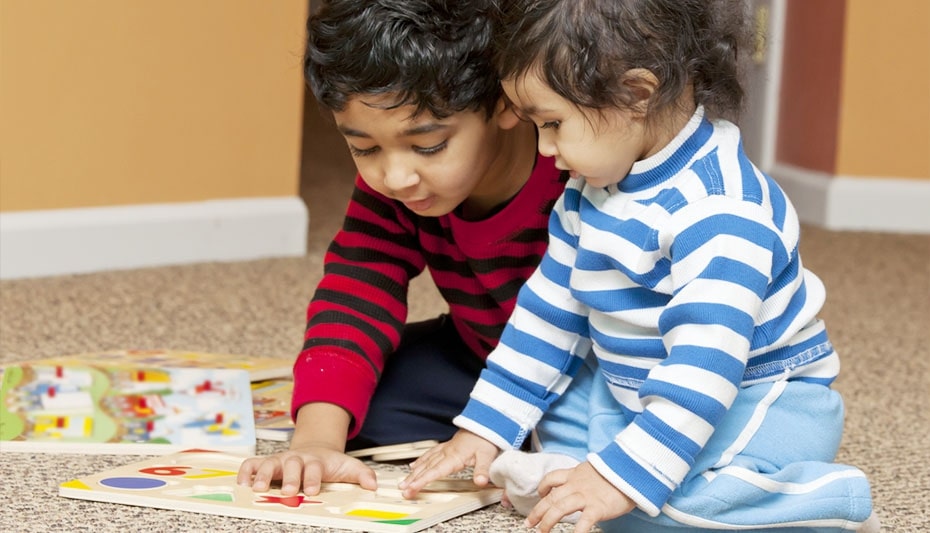
Puzzles come in various themes and topics: letters, shapes, numbers, animals, colours, the list goes on and on. They boost a child’s cognitive and memory capabilities, and putting a puzzle together increases a child’s visual spatial awareness.
Your preschooler’s memory skills will be strengthened as they learn to recognise the simple shapes and colours that make up the entire puzzle. It also hones their logical and problem-solving skills as they learn how to formulate a method to achieve their goal – to complete the puzzle. This skill can be transferable to their adult life.
Pro-tip: Find puzzles that appeal to your child’s interests. Does your child love animals? Is your child stuck on trains and rockets? Your best bet is to find puzzles that incorporate these “loves”.
11) Toy Train Sets
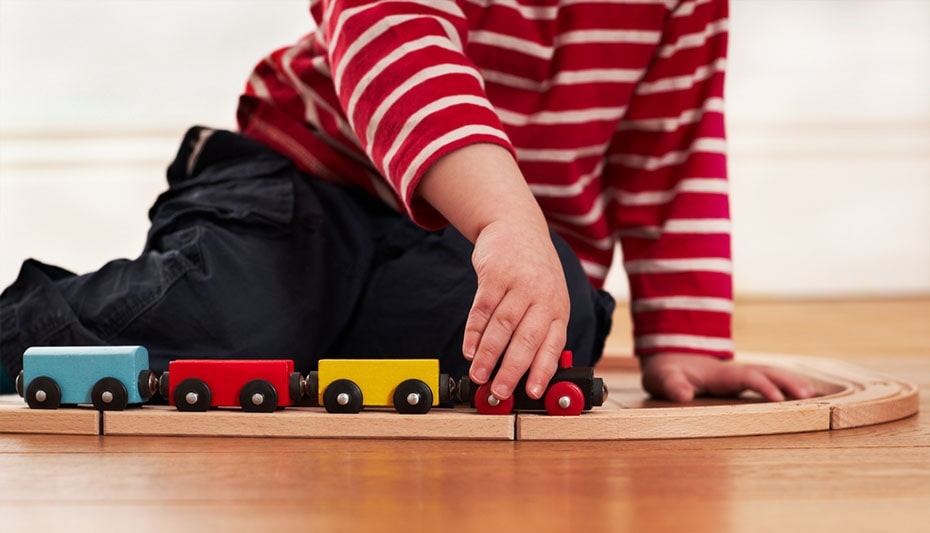
These classic toy trains are more educational than you might think. By playing with a toy train set, your child learns how to build and put together the tracks in a manner that allows the train to move smoothly — enhancing logical-thinking skills.
It also helps develop preschoolers’ fine motor skills and increases dexterity as they manipulate small objects to create towns or landmarks for the trains to travel through.
More interestingly, it involves tapping into their organisational skills as they fix the different elements together. While it might take some time for them to acquire this skill, increased exposure at an early age will help them prepare these skills for later life.
Pro-tip: Combine your child’s toy train set with other toys. Place toy dinosaurs around the track to unleash your preschooler’s magical sense of imagination into a prehistoric world.
12) Dress-Up Costumes
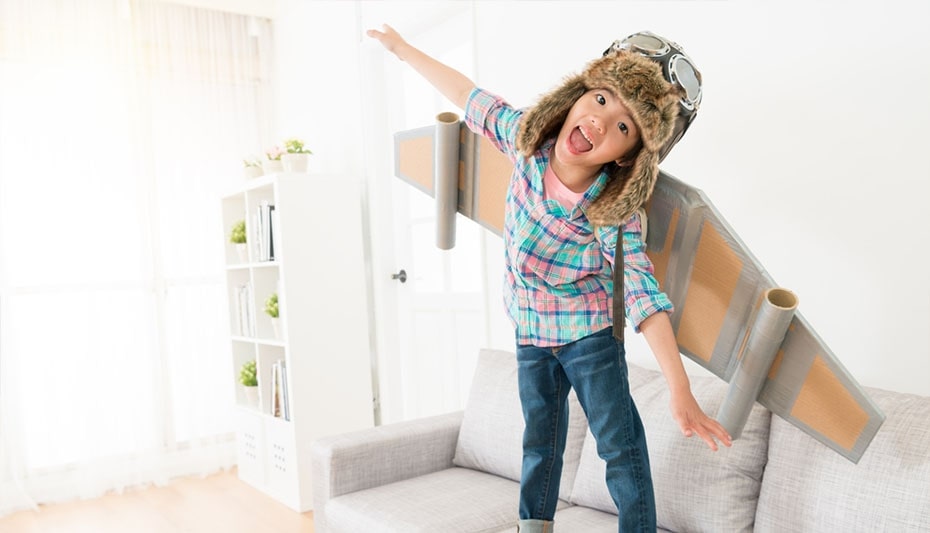
Let your child’s creativity take flight as they take on the role of a favourite character through playing dress-up.
There’s more to dressing up than meets the eye. Your child’s mind is actually hard at work, thinking and rehearsing the actions he/she needs to take in order to fulfill the role. As such, it hones a child’s ability to sequence (put events in a logical order).
Role-playing also builds language and literacy skills as a child interacts with others as their chosen character.
Pro tip: Look for “props” your child can use as they develop their stories. Encourage your child to act it out, drawing out details. Don some of the clothing yourself.
13) Easel
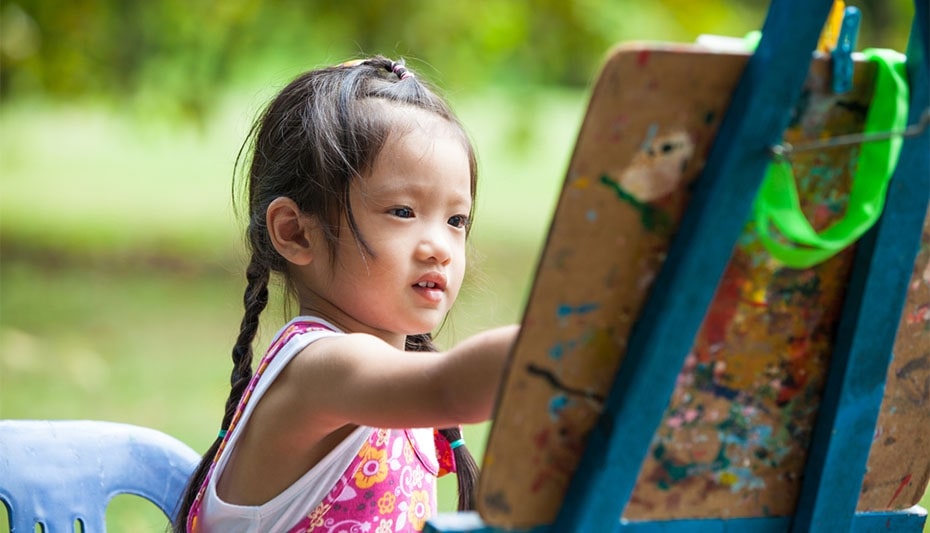
Painting on an easel will help your little one build self-confidence as they learn how to bring ideas to life. Your child also makes decisions along the way as they use art materials, such as choice of colours. This too, will apply to other scenarios as your child grows older — integrating learning into everyday life.
Using an easel aids the development of your child’s cognitive skills as they figure out the steps required to complete their work. Many things come into consideration: how the paint gets on the paper, the way the different colours mix, and how to handle the drips that occur. Lastly, your child’s motor skills will be further developed as painting involves the entire shoulder and arm.
Pro-tip: Sit with your child as they draw from time to time, and never say, “I can’t draw” in front of them. Encourage your child to doodle circles, squares, spirals, letters — anything!
14) Picture Books
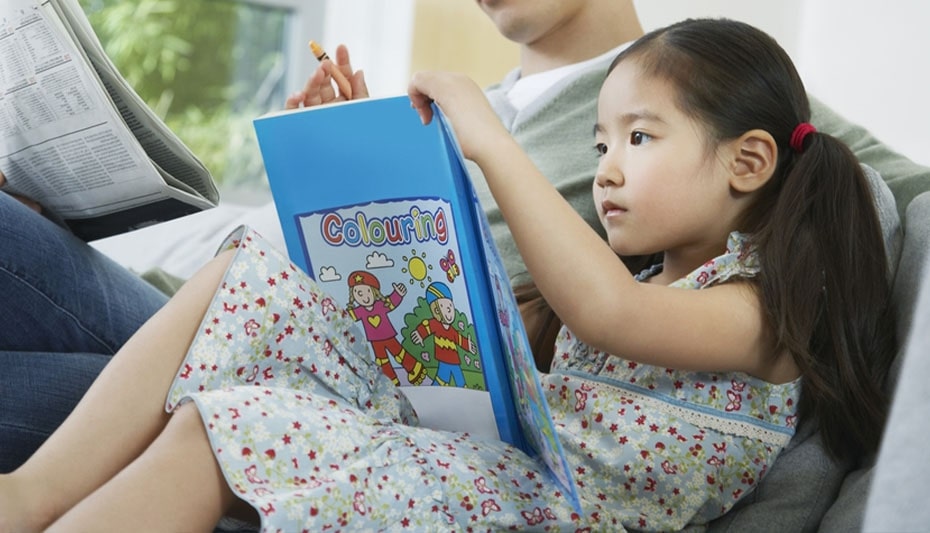
Picture books encourage verbal interaction, and reading aloud with a parent helps in developing a child’s confidence, especially before “reading aloud” lessons at school. Verbal dexterity is an important skill to develop, and complements literacy.
Read a book with your child, and encourage them to “read” just like you. Maybe your little one can’t read that well yet. Even then, your child will learn by watching you hold a book in the proper manner and seeing how you navigate through the book by gently turning the pages.
Pro tip: Choose books that are the right length for your child, preferably those that match their changing interests. For a change, you could talk about the pictures in the book instead of reading the words. Why not try making up a story together with your little one?
15) Toy Food and Play Kitchen
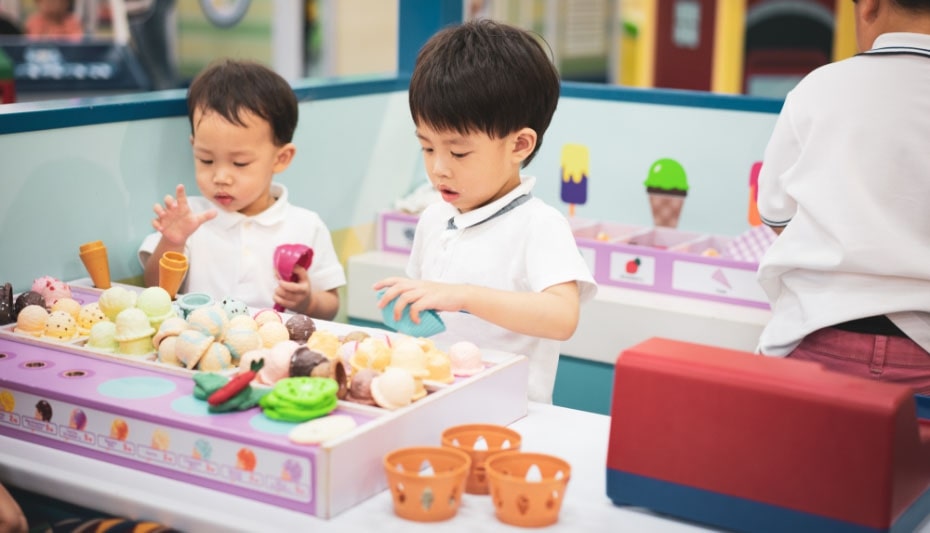
With educational toys such as these, your little one gets to experience being a cook! Pretend chopping and stirring food in the pan to develop your child’s fine motor skills. Your child’s imagination takes flight as they create new “recipes”. Children involved in “play cooking” also learn about household chores and the importance of a balanced diet and healthy food.
Pro tip: As your child plays with various toy foods, point out the main nutritional benefit of each item in real life: “Did you know that drinking milk makes you strong like Mummy and Daddy? It’s because of something in it called ‘calcium.’”
16) Domino Set
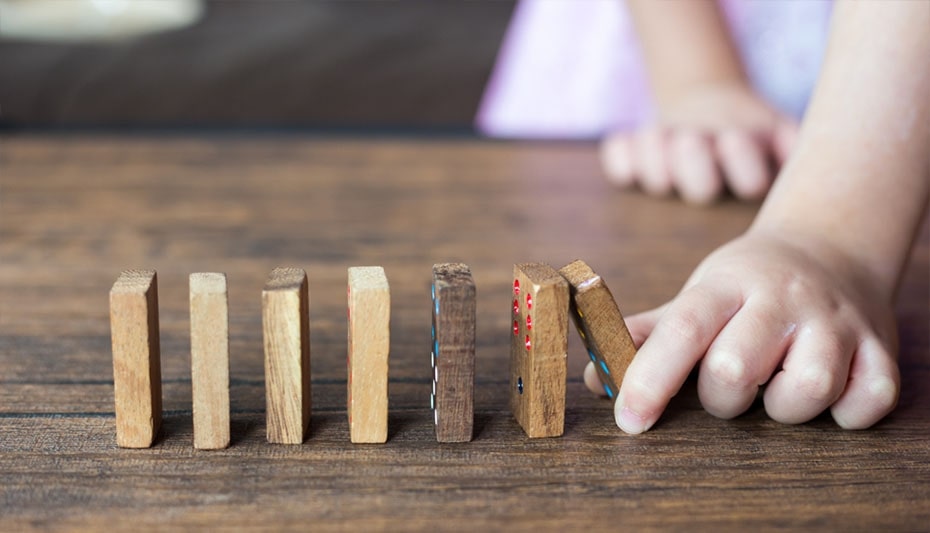
As simple as it may seem, playing with dominoes helps a child acquire spatial and tactile skills. Dominoes teach them to manipulate the blocks and arrange them in a certain order, and in careful and precise movements.
When your child pokes at the first block to topple the rest , they learn about cause and effect. With this knowledge, they engage in trial and error to prepare for a successful knock-down of the blocks. In the process, they learn aspects of problem solving.
Pro-tip: Besides toppling these domino blocks, you can have your child stack them. They can build houses or domino buildings. This tests their ability to balance and maintain stability in their hands and arms.
17) Playdough
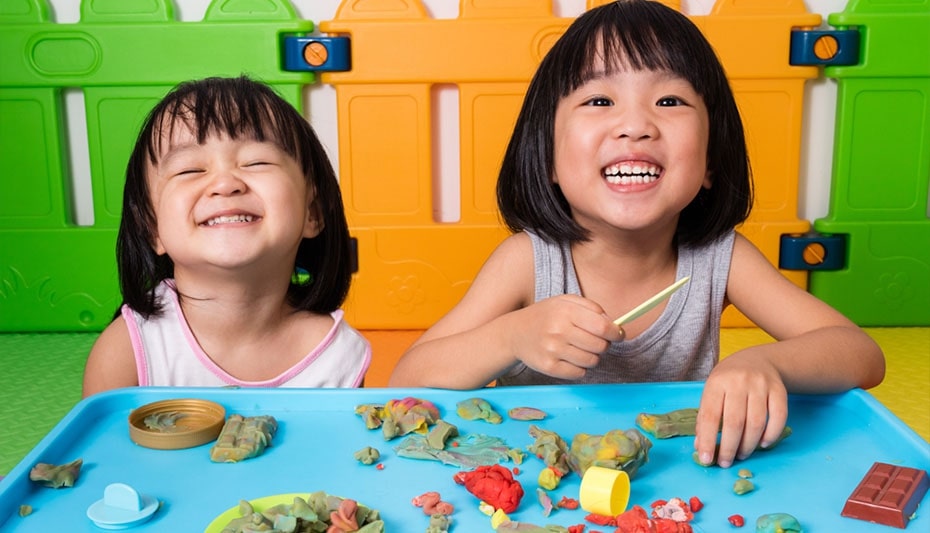
Playdough encourages curiosity and experimentation. A child learns how to come up with their own ideas, analyse (How much dough is needed to make an apple?), and solve problems (How do you connect the playdough arms to the body?). They also learn how to compare and contrast through their creations (e.g. how to create a ball shape versus an egg shape).
These skills that your child picks up in the process can facilitate learning, including how to tackle lessons at school.
Pro-tip: Pounding, squeezing, cutting and flattening playdough provide a safe outlet for a child to release excess energy and cope with strong emotions.
Primary schoolers
This is an exciting time for even more growth as this is when children’s talents and interests take hold. They have a better understanding of the world around them, and now they are moving towards mastering skills that once challenged them.
Expect your child’s physical abilities such as gross and fine motor skills to be refined, and let your little explorer embark on new adventures, with your supervision of course.
Above everything else, as much as your child views peer relationships to be of paramount importance, you are still Playmate #1, so try to carve out some one-on-one time together.
18) Musical Instruments
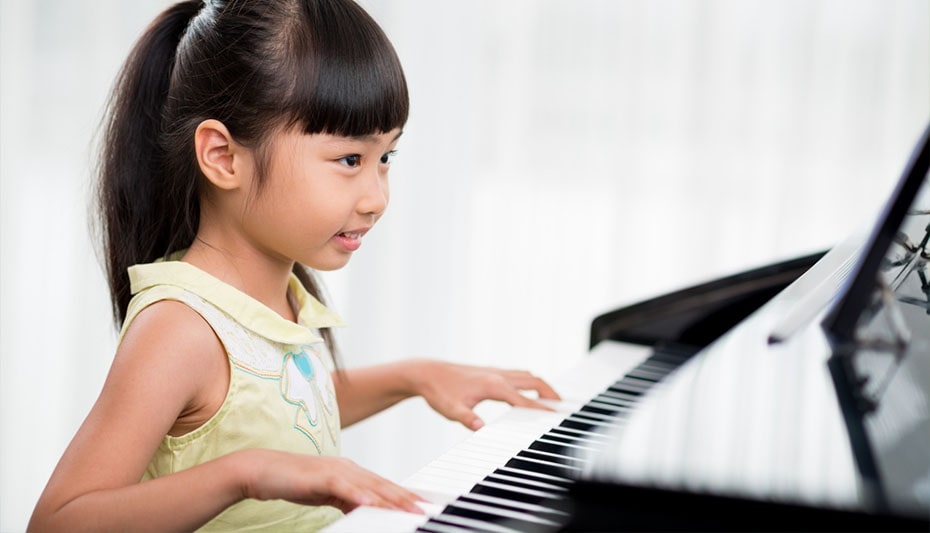
Learning to play a musical instrument will keep your child’s brain sharp because musical training can alter brain structure and function positively, according to science . Especially for those who start at a young age, a musical education can contribute to better verbal, spatial and mathematical performance.
Expose your child to a variety of instruments such as percussion instruments like keyboards, xylophones, maracas, and tambourines. Learning to play the piano, violin, guitar, or another instrument helps develop fine motor skills and builds attention skills that contribute to better control of behaviour.
Pro-tip: The strict discipline of learning an instrument can be discouraging for children. Let them take the lead by teaching songs they know, giving them the freedom to choose their instrument, and ensuring that they still have time to play with friends and siblings.
19) Magnetic Tiles and Blocks
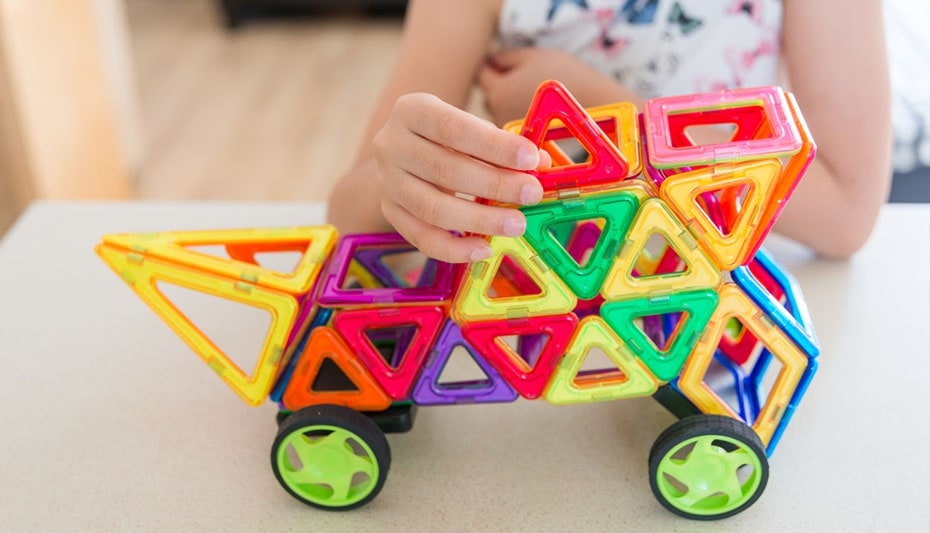
STEM approved!
These magnetic tiles are where maths, science and creativity meet! Your little one can spend hours stacking, building, counting, matching and “clicking” their creations together while developing spatial and tactile skills. All these actions help to develop fine motor skills in children.
Pro tip: Set a timer to see how fast your child can build or how many creations they can come up with within a specific time. This is a good opportunity to learn about goals and deadlines.
20) Chess
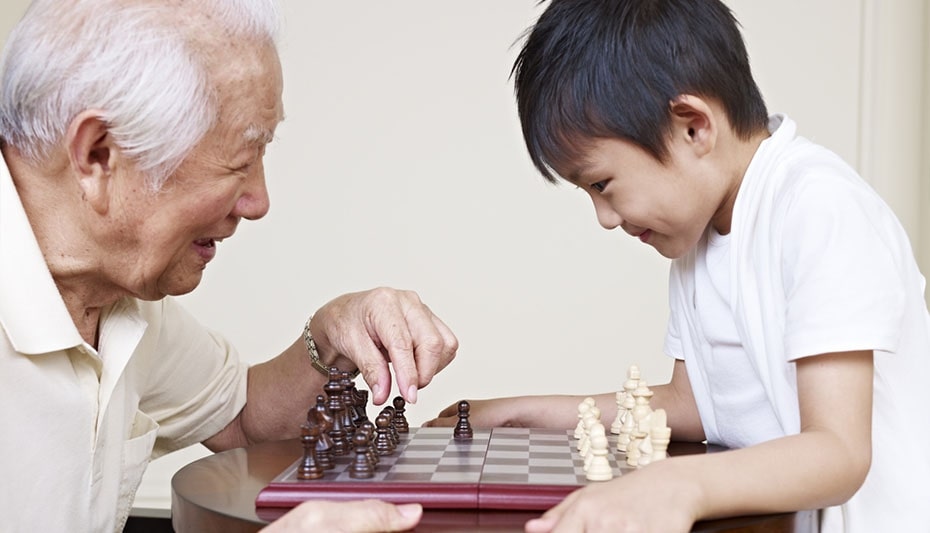
Chess is widely loved by kids and adults alike and its benefits are far-reaching.
Behind a single, calculated move is a lot of brain power that involves many things. A child learns how to make sense of the rules, plan ahead, and apply strategies and tactics. Chess also teaches your child other lessons that can be learned from many sports, such as turn-taking, negotiating rules, and fair play. In addition, chess can be a great way to teach your child how to manage those big emotions that come with winning or losing.
Pro-tip: If you child has no one to play with, let them play both sides of the board. This will teach them to see the game from their opponent’s perspective.
21) Construction Play Sets
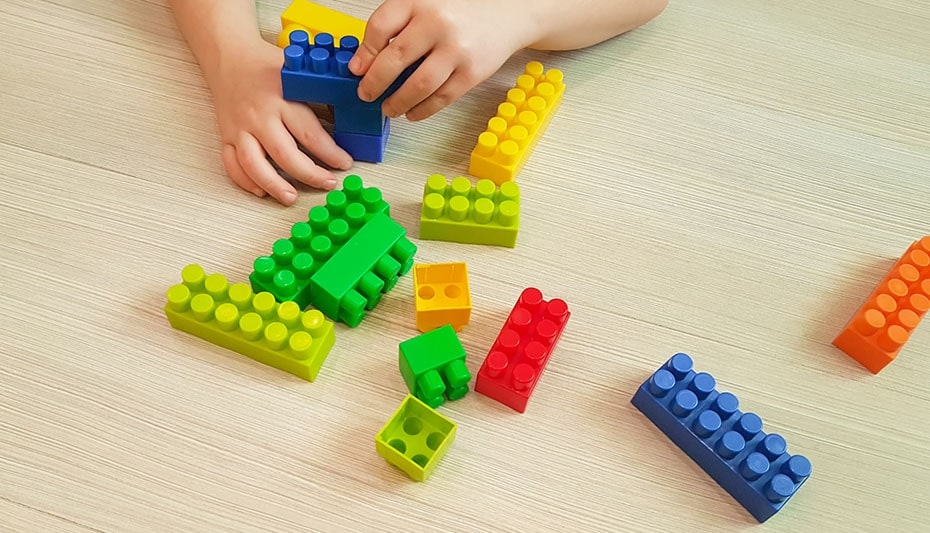
Construction play can contribute to the way children think and complete tasks. They are a big part of helping our little learners succeed in school. Why?
These popular play sets teach kids social-emotional skills like cooperative play where kids work together to create elaborate structures. Free play with construction blocks has even been shown to increase sixth-grade students’ performance in math word problems.
As kids connect blocks and build objects, they also learn how to tinker and experiment, explore cause and effect while hypothesizing and developing curiosity.
Pro-tip: Encourage storytelling with your child after completing a set. Ask your child to weave a tale around the construction and talk about the characters.
22) Jump Rope
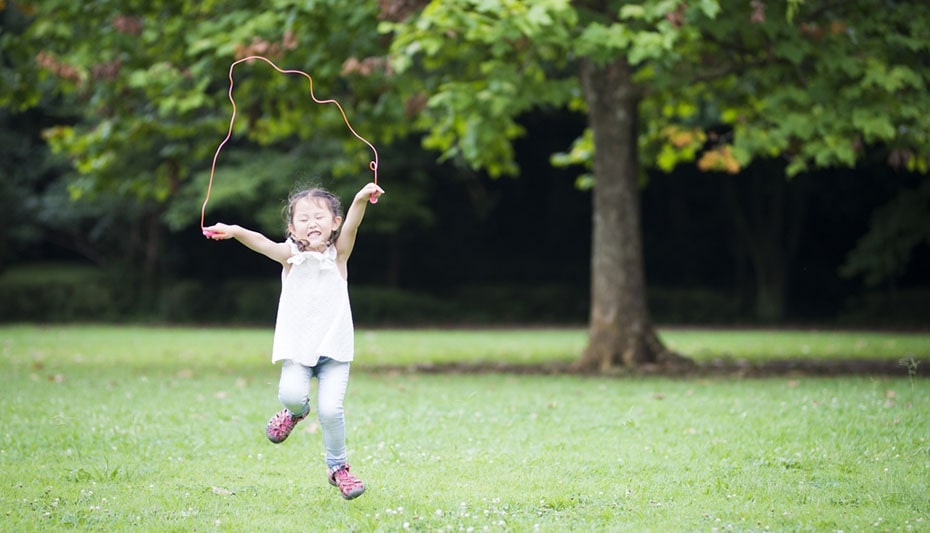
It’s a classic toy that can introduce your kids to physical activity.
Jumping rope improves coordination skills as it involves knowing when to swing the handles and then jumping at the right time. Besides strengthening the back, arm, and calf muscles, it also improves cardiovascular fitness.
Other benefits of jumping rope include improvement in agility, reaction time and creativity as your child explores different moves and varying speeds.
Pro-tip: You can introduce rhymes that go along with skipping motions. Or your child can create their own rhymes.
23) Stencils and Drawing Art Sets
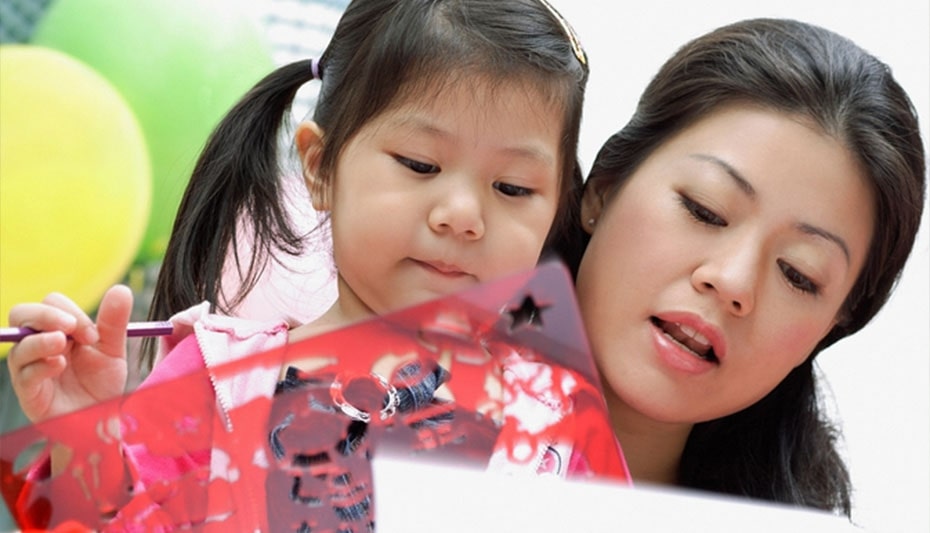
Children will be so entertained by stencil kits that they won’t even realise that they are learning. Handling pencils also develops fine motor skills and enhances the motivation to write and draw.
The simple act of stenciling offers more benefits than you might think. It unleashes creative thinking and also helps build cognitive skills to follow structure.
Pro-tip: Let your child try stenciling on various textures other than paper such as fabrics and even wood.
24) Scrabble
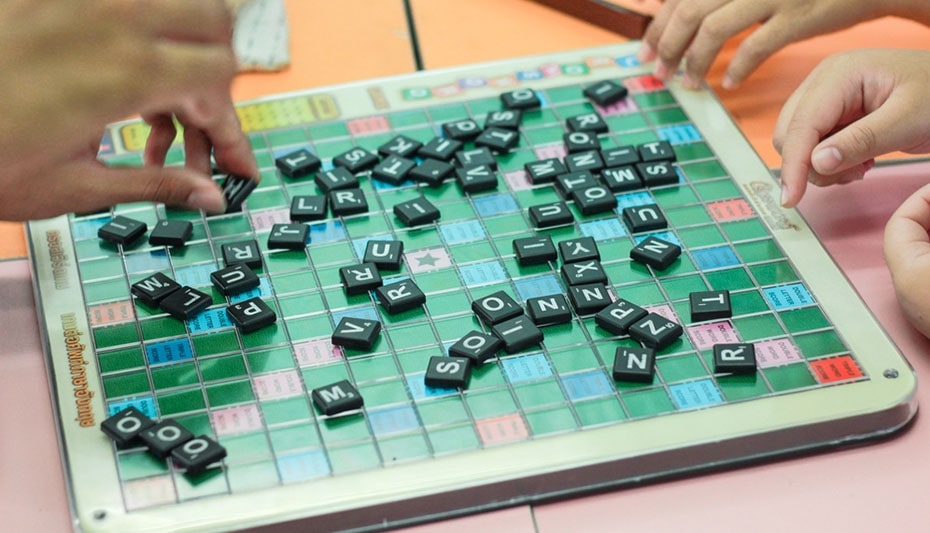
Word games like Scrabble are great for improving children’s speech and language skills. As children make links with written words, they build their vocabulary as well as their reading and writing skills.
Playing Scrabble also helps to improve basic maths skills: kids have to apply addition and multiplication methods for every word they create on the board, as each tile of every letter in the game carries specific points.
It also encourages them to listen and take turns within the family.
Pro-tip: Take it up a notch. If your child is ready to handle it, play “mental Scrabble” with them using just a paper and pencil. The rules are simple: give your child some letters and challenge them to form words using them!
25) Science Toys
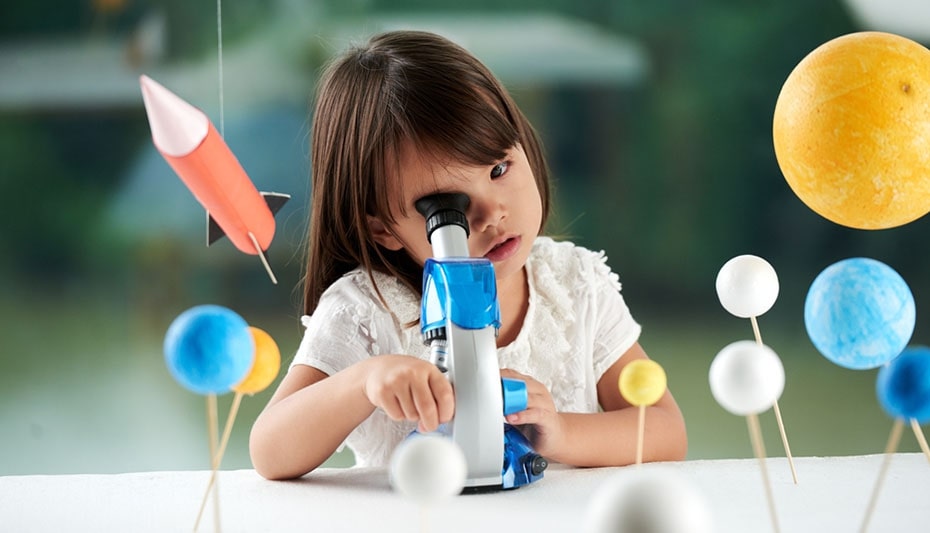
Pique your preschooler’s curiosity with toys or objects that allow them to explore and test out ideas or theories. The more your child takes on a hands-on approach, the more they will actually learn by engaging their problem-solving mind.
Because of their high educational value, science-related toys such as chemistry sets, binoculars and telescopes are great for primary school kids. They help to improve math and science skills and enhance critical thinking and learning skills.
Pro-tip: Wait before jumping in with solutions if your child is struggling with an experiment. Give your child the time and space to explore and discover on their own.
References:
- https://naeyc.org/resources/topics/play/toys
- https://kidshealth.org/en/parents/smart-toys.html
- https://www.aoa.org/patients-and-public/good-vision-throughout-life/toys-games-and-your-childs-vision
- https://www.healthxchange.sg/children/parenting-tips/choose-toys-babies-children
- https://edition.cnn.com/2013/09/09/living/parents-kids-body-type-music-instrument/index.html
- https://www.arktherapeutic.com/blog/how-stacking-nesting-toys-can-develop-early-language-and-fine-motor-skills/
- https://sg.theasianparent.com/12-18-month-old-toys
- http://musicianbrain.gottfriedschlaug.org/papers/Schlaug_Music_Child_Brain_NYAS2005.pdf